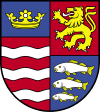Prešov Region
Prešov Region Prešovský Kraj | |||
|---|---|---|---|
Region | |||
| |||
 Presov Region | |||
| Country | |||
| Capital | Prešov | ||
| Government | |||
| • Governor | Milan Majersky (elected 4 November 2017) | ||
| Area | |||
| • Total | 8,973.69 km2 (3,464.76 sq mi) | ||
| Highest elevation | 2,654 m (8,707 ft) | ||
| Lowest elevation | 105 m (344 ft) | ||
| Population (2013 census) | |||
| • Total | 818,916 | ||
| • Density | 91/km2 (240/sq mi) | ||
| Time zone | UTC+1 (CET) | ||
| • Summer (DST) | UTC+2 (CEST) | ||
| Website | www.po-kraj.sk | ||
The Prešov Region (Slovak: Prešovský kraj, pronounced [ˈprɛʃɔʊ̯skiː ˈkraj], Polish: Kraj preszowski, Ukrainian: Пряшівський край) is one of the eight Slovak administrative regions and consists of 13 districts (okresy) and 666 municipalities, from which 23 have a town status. The region was established in 1996 and is the most populous of all the regions in the country.[1] Its administrative center is the city of Prešov.
Contents
1 Geography
2 Demographics
3 Administrative division
4 See also
5 References
6 Further reading
7 External links
Geography
It is located in the north-eastern Slovakia and has an area of 8,975 km². The region has a predominantly mountainous landscape. The subdivisions of Tatras – High Tatras and Belianske Tatras lie almost entirely in the region and include the highest point of Slovakia – Gerlachovský štít (2,654 ASL). Other mountain ranges and highlands in the region are Šarišská vrchovina, Čergov, Ondavská vrchovina, Slanské vrchy, Pieniny, Levoča Hills, Laborecká vrchovina, Bukovské vrchy, Vihorlat Mountains and Eastern Slovak Lowland. The basins in Prešov Region are Podtatranská kotlina, Hornadská kotlina and Košice Basin.
Major rivers in the region include the Poprad in the west, which is the only major Slovak river in the Baltic Sea watershed, a small part of Hornád in the south-west, a small part of Dunajec in the north, the Torysa in the centre and the Ondava and Laborec in the east. As for administrative divisions, the region borders on the Lesser Poland and Subcarpathian voivodeships in Poland in the north, Zakarpattia Oblast of Ukraine in the east, Košice Region in the south, Banská Bystrica Region in the south-west and Žilina Region in the west.
Demographics
The population density in the region is 90.8 inhabitants per km², which is below the country's average (110 per km²). The largest towns are Prešov, Poprad, Humenné, Bardejov and Snina. According to the 2011 census, there were 814,527 inhabitants in the region, with a majority of Slovaks (90.7%), with minorities of Roma (4.0%), Rusyns (2.7%) and there are small minorities of Ukrainians (<1%) and Czechs (<0.5%).[2]
Administrative division
The Prešov Region consists of 13 districts. There are 666 municipalities, of which 23 are towns (in bold), where about half of the region's population live.
See also
- Spiš
- Šariš
- Zemplín
- Union of Carpathian Youth
References
^ "Demografia Prešovského samosprávneho kraja - VÚC Prešov" (in Slovak). Po-kraj.sk. Retrieved 2013-08-19..mw-parser-output cite.citation{font-style:inherit}.mw-parser-output q{quotes:"""""""'""'"}.mw-parser-output code.cs1-code{color:inherit;background:inherit;border:inherit;padding:inherit}.mw-parser-output .cs1-lock-free a{background:url("//upload.wikimedia.org/wikipedia/commons/thumb/6/65/Lock-green.svg/9px-Lock-green.svg.png")no-repeat;background-position:right .1em center}.mw-parser-output .cs1-lock-limited a,.mw-parser-output .cs1-lock-registration a{background:url("//upload.wikimedia.org/wikipedia/commons/thumb/d/d6/Lock-gray-alt-2.svg/9px-Lock-gray-alt-2.svg.png")no-repeat;background-position:right .1em center}.mw-parser-output .cs1-lock-subscription a{background:url("//upload.wikimedia.org/wikipedia/commons/thumb/a/aa/Lock-red-alt-2.svg/9px-Lock-red-alt-2.svg.png")no-repeat;background-position:right .1em center}.mw-parser-output .cs1-subscription,.mw-parser-output .cs1-registration{color:#555}.mw-parser-output .cs1-subscription span,.mw-parser-output .cs1-registration span{border-bottom:1px dotted;cursor:help}.mw-parser-output .cs1-hidden-error{display:none;font-size:100%}.mw-parser-output .cs1-visible-error{font-size:100%}.mw-parser-output .cs1-subscription,.mw-parser-output .cs1-registration,.mw-parser-output .cs1-format{font-size:95%}.mw-parser-output .cs1-kern-left,.mw-parser-output .cs1-kern-wl-left{padding-left:0.2em}.mw-parser-output .cs1-kern-right,.mw-parser-output .cs1-kern-wl-right{padding-right:0.2em}
^ "POPULATION AND HOUSING CENSUS 2001 - Tab. 3a". Web.archive.org. 2006-11-29. Archived from the original on November 29, 2006. Retrieved 2013-08-19.CS1 maint: Unfit url (link)
Further reading
Kopa, Ľudovít; et al. (2006). The Encyclopaedia of Slovakia and the Slovaks. Bratislava, Slovakia: Encyclopaedic Institute of the Slovak Academy of Sciences. ISBN 80-224-0925-1. External link in|publisher=(help)
External links
| Wikimedia Commons has media related to Prešov Region. |
Prešovský samosprávny kraj Official website

